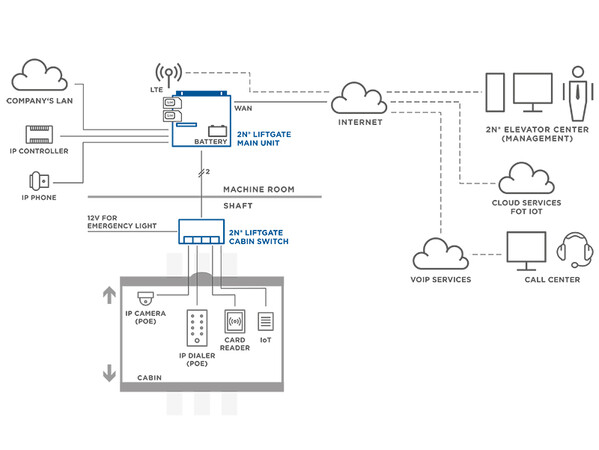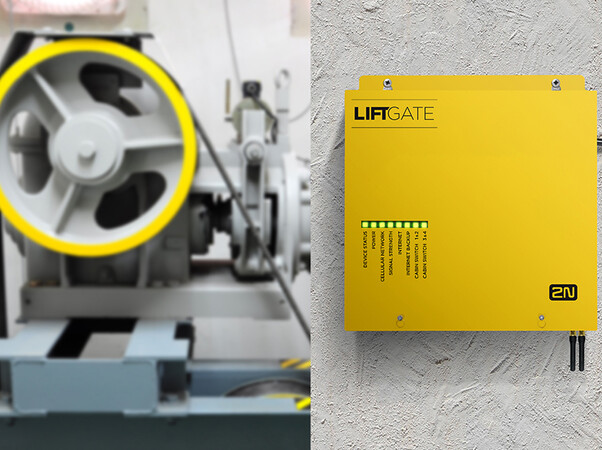LiftGate combines all functions
The company 2N had launched the product 2N LiftGate. It combines the functions of an LTE router, a backup power supply, a converter (2-wire to IP) and a switch all in one unit.
Whether commercial or residential, new buildings today should be both smart and connected. Elevators need to be far more than simply a means of moving people quickly and safely between floors. They should be an inherent part of the security system and integral to the flow of people through the building. To do this, they need to work seamlessly with the rest of the building’s ecosystem.
This has been a real challenge for technicians for many years – it can be tricky getting IP connectivity to the cabin. WiFi will never be reliable in a shaft environment – there will be interference, dropouts, etc. And emergency communication is all about reliability. That is why, similarly, communication gates are installed in the engine room or completely up in the shaft, so that there is a mobile signal.
Most companies still don't want to run structured cabling through the shaft along or within the travelling cable, either because of cost, space or distance limits, states the company 2N.
Get IP into the elevator car using two wires
 Photo: © 2N Telekomunikace
Photo: © 2N TelekomunikaceAccordingt to the company, the 2N LiftGate is the first product, which avoids the need to invest in special elevator infrastructure. With just two conductors in the travelling cable, the IP connectivity get right into the elevator car. This IoT gateway combines the functions of four devices in one: an LTE router, a backup power supply, a converter (2-wire to IP) and a switch. "It saves money whilst simultaneously reducing the likelihood of failure", stresses 2N.
The main unit typically sits in the shaft or machine room and has a SIM card, providing both call and data connectivity to use for an IP controller or access control system, for example. A WAN port or a second SIM are usually used as a backup option.
Backup power in the event of a power failure
The 2N LiftGate solution is also a cabin switch which utilises one pair in the travelling cable to get data and power from the main unit. For critical IoT devices in the car, such as an emergency IP communicator or camera, the switch provides you with two Power over Ethernet (PoE) ports, according to IEEE 802.3af standard. PoE is a method of powering over the data infrastructure, i.e., the same infrastructure (Ethernet cable) that is used for communication is used for power. This saves wires and, in addition, the 2N LiftGate also provides backup power in the event of a power failure.
For non-critical IoT devices, such as an advertising panel with remotely customisable content, the switch has two other ports without PoE, which means these devices will be powered from the cabin’s power supply.
New firmware which has just been added to the 2N LiftGate which has upgraded the product’s capabilities even further, improving system stability during remote configuration, enhancing cybersecurity and making the product even more reliable when connecting calls during dangerous situations, says the company.
Why use an IP-based emergency dialler?
 Photo: © 2N Telekomunikace
Photo: © 2N TelekomunikaceTo make the elevator emergency communication solution complete and purely IP-based, the last step is to select the right IP communicator. One example is a second product, the new 2N LiftIP 2.0, an IP emergency dialler which uses VoIP technology for transmitting calls from the elevator cabin to the alarm centre. It supports full-duplex communication and the clarity of the voice communication.
The integration capabilities of IP technology also mean that these calls can be connected to the video from the IP camera installed in the cabin, giving the operator an immediate overview of what’s going on. You have IP dialler (2N LiftIP 2.0) in the cabin (and you can have there more IP devices such as card readers for authorized access to specific floors or IP camera for the video streaming from the cabin).
All these devices are connected via Ethernet cable to the 2N LiftGate Cabin Switch which is typically on the top of the cabin (or somewhere behind the panel). Then, this cabin Switch is connected with 2N LiftGate main unit just via 2-wires (typically from the travelling cable). These 2-wires are capable to transfer IP data. And then, you have 2N LiftGate in the machine room which forward the call or other data from the cabin outside (to the call center, dispatch center, etc.).
The product is also the ease of installation, as it can use existing IP infrastructure and the PoE power supply, only needs one IP cable, and requires no additional accessories.
Upgrade the devices remotely
Thanks to IP technology and tools such as the 2N Elevator Center cloud portal, it's now possible, to monitor all IP devices for emergency communication 24/7, says 2N.
It's also possible to manage them remotely in bulk and can even be notified via email about events such as the status of the gateway’s registration with the VoIP provider, a connection failure to the cloud or a switch to backup power. The user has instant access to logs and can even upgrade the devices remotely.
More information: 2n.com/en

























Write a comment